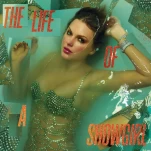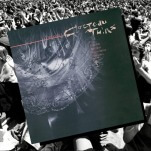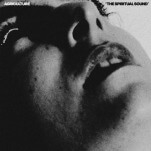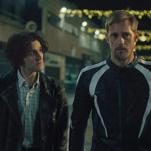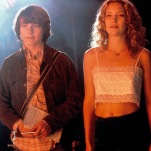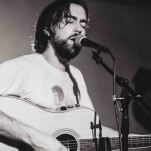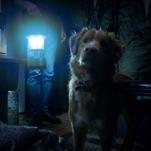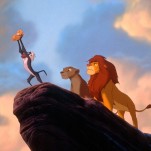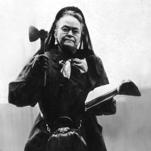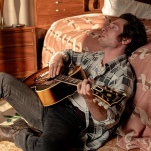Killjoys Showrunner Michelle Lovretta on the Series Finale and the Power of Joy
Photo Courtesy of Syfy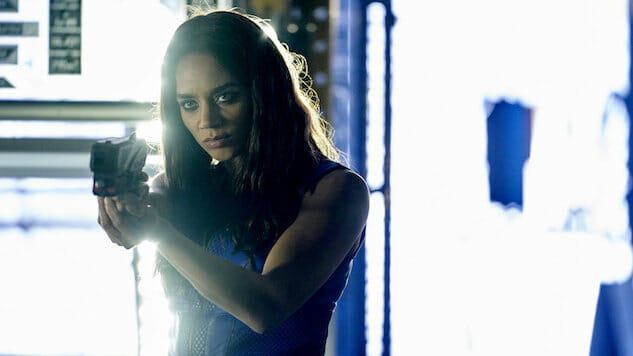
“Dibs on the big one”
No spoilers (yet), but that line, declared with lusty joy by a grinning, gun-wielding Dutch (Hannah John-Kamen), is the note that Killjoys, the snarky, lady-fronted, space-set bounty hunter romp that creator Michelle Lovretta brought to Syfy in 2015, ends on. And now …
![]()
This moment of pure joy comes right after a long-awaited I love you, too, which itself comes after a romantic transfusion of bright green alien blood between (mostly) reformed evil lady loves, which itself comes after the series’ beefiest cake screams in celebration at the promotion of his gender non-conforming husband to Lord Governor (“Ma, I made!”), which itself comes after a techno dance party in the middle of a prison ship. Somewhere in that final montage of joy is the return from oblivion of the resident science genius’ quippy, spider-infested love, the reorientation of the RAC’s mission to be the whole Quad’s defenders and soldiers, and the gift of a doll to the inhuman girl who nearly eradicated humanity.
The point is, for all the alien cloud consciousnesses Dutch and her team set ablaze in Episode 5.10’s final minutes, for all the deep-rooted emotional and psychological trauma Dutch has to overcome to both strategically work with and physically overcome her childhood abuser/mentor/father figure, Khlyen (Rob Stewart)—in order to beat The Lady (Alanna Bale) once and for all—and for all the thorny questions the series as a whole raises about all the dangers to humanity so parasitically entwined with the importance of institutional and cultural memory, Lovretta and her team manage to send Killjoys off the same way it came in: On a flying dagger laced with pure love and joy.
I could go on for days about how impressively Killjoys kept its action-filled, femme-fronted, deeply humane mission statement alive from “Bangarang” all the way through “Last Dance,” I really could, but a better use of your time would honestly be to just sit down and watch (or rewatch) the series for yourself. Besides, I don’t doubt that, sooner or later, there will be opportunity in the future for me to dive back in—at only 50 episodes long, and with so much wholesome queer content, such a tightly executed ending to the five-season narrative, and so much pure, snarky charm oozing from co-leads John-Kamen, Aaron Ashmore and Luke MacFarlane, Killjoys is bound to become a modern sci-fi classic.
In the meantime, Paste hopped on the phone with showrunner and series creator Michelle Lovretta to talk about the series’ trajectory, the rare two-season final pickup they got at the end of Season Three, and what the finale means both for viewers and for the characters themselves.
Editor’s note: The following interview has been lightly edited for length and clarity.
Paste: Congratulations on another stellar series finale, Michelle! How are you feeling, now that the end is finally here?
Lovretta: You know, I have to say it’s been unexpectedly and pleasantly emotional. We wrapped shooting quite a while ago, so I had sort of felt prepared and at arm’s length, but [now] I’m feeling incredibly nostalgic and just full of a shit-ton of love. And all the cast has been emailing each other, getting ready—it’s just been a great feeling of togetherness before the end.
Paste: Now that you’ve wrapped all the stories you’re going to wrap in this world, does anything—plot, character, anything—stand out as something you are especially proud of having been able to see through to the end?
Lovretta: I’m in love with quite a few journeys that the characters have taken. Sometimes I’m in love with them because they’re something that I didn’t in any way anticipate—that would be like a Turin (Patrick Garrow), a Fancy (Sean Baek), a Zeph (Kelly McCormack), characters that had either started off as small and I didn’t know if they would continue, or characters that hadn’t even been born in my head. Like Zeph didn’t exist until I created her later on in the series. So those things have been great because they’ve been kind of discoveries and surprises, and that’s the fun of writing TV.
The other angle on it that I am most satisfied with would be probably be… god, it’s really hard! Delle Seyah (Mayko Nguyen) would be one of them, because she has taken… she hasn’t had a journey, she’s had a fucking evolution, you know? But an evolution that I’d like to believe is credible, where you can still see the Delle Seyah that has always existed in the Kendry that now is, but things changed around her and things changed with them, and her last line, when she says, “I’m never going to be nice, but I’m gonna try to be good,” is exactly that character to me in one sentence. So to take her on that ride, to pair her with Aneela—I wish we could have had more real estate for the two of them on camera, it’s just really hard on production to try and schedule scenes for Aneela and for Dutch when you only have one Hannah. [Note: John-Kamen plays both roles.]
And then I have also really enjoyed watching Dutch heal, watching her to open up and trust and nurture beyond just John (Ashmore). And… yeah, fuck it, I’ll just say all of them! I mean, John, having him be bold enough to say, “I deserve to have some time on my own,” I think is huge growth. Having D’avin (MacFarlane) grow into somebody who started as super macho alpha and retains vestiges of all of that but has evolved also into somebody who is more complex and nuanced; he’s not just, you know, some archetype. They’re what the story is for me, it’s hard for me to even think of the world without all of them individually having these stories, so it’s hard to pick favorites!
Paste: One of the things we’re most eager to hear you talk about is the rare “two final seasons” renewal Killjoys got back at the end of Season Three, and how that long (for the genre) and uniquely definite runway played into how you guys approached wrapping up Dutch, Johnny, and D’avin’s story.
Lovretta: That was a really pleasant surprise. It’s something you certainly hope for, to have your network be able to say, “okay, here it is, this is the amount of road that you have.” They rarely have the luxury, themselves, but if they’re able to, even it’s only twenty episodes, it’s just a treat.
As for how it affected our approach—by the end of Season Three, I had asked my co-EP Adam Barken if he would showrun so I could take a step back to be able to breathe a little bit and keep my eyes on a larger picture. And then we found out about the 20-episode renewal and it was like, okay, now we have quite a lot of story to tell! So that worked out perfectly, we were able to be more creative trying to figure out between the two of us, okay, how do we task this out? It was really one of the better creative experiences that I’ve had, one of the better partnerships that I think I could have, so hopefully that bleeds through on the screen.
Paste: Were there any stories you got to tell in these last two seasons that you might not have been able to, without having the double-season runway? Last time we spoke, when we asked what dream storylines might be in Killjoys’ future, you mentioned wanting to dip into an alternate reality where Dutch and Johnny were in a romantic relationship, and then this season…
Lovretta: Oh, we would definitely not have done that! There were a lot of things that we had to resolve from Season Three—we’d left all of the characters in different worlds, and it takes a while to reunite people, and there’s only so much story that you can tell within one season’s ten episode run. If we had tried to carve out space to do anything with an alternate reality, it would just have been a bit [too] intense. Also, we liked the idea of it (Dutch and Johnny’s surprise alternate reality marriage at the end of “Sporemaggedon,” 4.10) being a cliffhanger, but you [usually] want to be kind to the audience and not mess with them too much in case your show doesn’t come back, right? So the way that we ended that season, we would never have done it without knowing for sure that we were coming back. Like, that’d be kind of a dick move, you know? Oh, she’s in bed with Johnny! Sorry! Bye! We just couldn’t do that! So what was so great about knowing that [we had the two-season renewal] was that it bought us that opportunity, that we could throw a big curve ball and be bold like that.
Paste: We know what our preference on the matter is (platonic friendships forever), but for the record, was there ever any kernel of possibility that that alternate reality marriage would put Dutch and Johnny’s relationship on any kind of romantic track back in the real world?
Lovretta: No. There may have been [interest] in the room, there may have been with directors, but there never was with me. That was basically one of my rules—certainly not in a draconian sense, it was something that the team also agreed—but it’s not what I wanted out of the series, it’s not what felt true to me about the characters. Doubt feels true, doubt feels organic, it feels healthy, and it felt like it’s a beautiful message for us to put out there, that doubt—in any relationship, whether it’s romantic or platonic—temptation that you shouldn’t have within that relationship, it doesn’t mean that that relationship is over, or that the rules were wrong, or that you actually want something else. You just take a breath, and if you want to get past that, you can. And I really wanted to show a male and female platonic friendship that encountered that temptation, one-sided or both, and moved past it, because that kind of friendship is so valuable.
Paste: One of the things we particularly loved about that arc was that, by expressly shutting down any last-minute romantic feelings springing up between the show’s best friends, it let other, more nuanced things blossom between the characters, things that were just as prickly and tangled as romantic feelings, but that had zero grounding in romance.
Lovretta: People are always trying to follow a very simple paradigm of, there is boy, there is girl, put boy with a girl, drama ensures. And I’m like, there is boy, there is girl, there is family. And to me, that’s a different set of rules, right, at least within these two. And the perspective I have on John is that he is somebody who has been very dear friends with somebody who has been traumatized. Dutch has been through trauma, she’s dealing with trauma, and I think when you have a very intimate relationship with any sort with somebody dealing with those sorts of issues, you can lose yourself a little bit, because it’s very important to be the shoulder, it’s very important that you be the support. And you willingly do that, and he willingly did that.
And I like the idea of what it says that John is okay with leaving now, and that Dutch is okay with him leaving. Although it might make some people sad, to me, it says something beautiful about how they’ve evolved past a panic or a possessiveness of each other. They are concrete now. So he gets to breathe a little bit, gets to have an adventure, gets to have other people see Johnny just as Johnny, and then he gets to bring all of that back. I’m sad I’m not planning on writing what he brings back! But I do feel like it will be great.
Paste: One of the keys to Killjoys’ success these past five seasons is how expertly it has always managed to balance humor and joy with both intense action and serious ideological, political and emotional (speaking of trauma) drama. This was a signature of your last show, Lost Girl, too. How do you manage to strike that balance so well?
Lovretta: In the end, I think that specific balance is innate to who I am. It’s how I experience the world, and it’s what I try to put out in the world. I try to find and hold on to joy. Joy is not positivity. It’s not naive. It’s pretty fucking powerful.
But at the same time, like Johnny, I have known people who’ve been through trauma, and I’m aware of really dark shit in the world, and so that makes me want to hold on to that joy even tighter. And to not be fraudulent! Because you can’t just be a bunch of quips, you can’t just be, everybody always survives. You have to find that balance, and everybody’s balance in storytelling is going to be a little bit different, but I think mine feels fairly consistent. It’s about having the deep connections and relationships be something that gives people ballast, that when they’re in the bad times, it gives some laughter, and when there’s good times, [it keeps them grounded.]
Paste: On that note of joy, we have to talk about that killer punk/pulp-art title sequence. When it showed up at the start of Season Two, it was like, yes, THIS is the show, and then you’ve got the final shot of the whole series morphing to echo it? What a concept!
Lovretta: Yeah! I think that idea might have been from Karen Troubetzkoy, a dear friend and our secret weapon, who is the executive producer on the show, I think she was the one who thought of superimposing that last image, which I think is great. But in terms of how the title sequence change came about, I think it was just, we wanted to have a different vibe. We did know that the show was going to change its tenor over time, and sometimes that helps you let the audience know that you’re switching gears a little bit, but I’m a fan of it, and I will always hear that tune in my head and smile.
Paste: What’s especially great about that final image is, it really drives home something you said when we talked during Season Three, that as far as you’re concerned, there is always going to be more story. It’s the end of our road with Killjoys, but as that final shot shows with so much joy, it’s only the start of a new one for them.
Lovretta: That was really important to me. Of all the notes I tried to strike in the finale, that was the truest. I think you can’t believe that those characters are just going to go and be domestic. Not that those things can’t be exciting, they can, but that’s not the path Dutch and Johnny and D’avin have been on. It just it makes me feel good knowing those snarky bastards are out there, at least in my pretend universe, still kicking ass and getting into trouble. And I think that was the most fitting send-off I could give them.
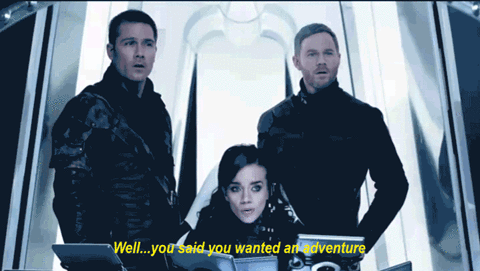
Killjoys is currently available to stream in its entirety on Syfy.com, provided you have a cable subscription to log in with. For cord-cutters, Killjoys is available exclusively on VRV.
Alexis Gunderson is a TV critic and audiobibliophile. She can be found @AlexisKG.
